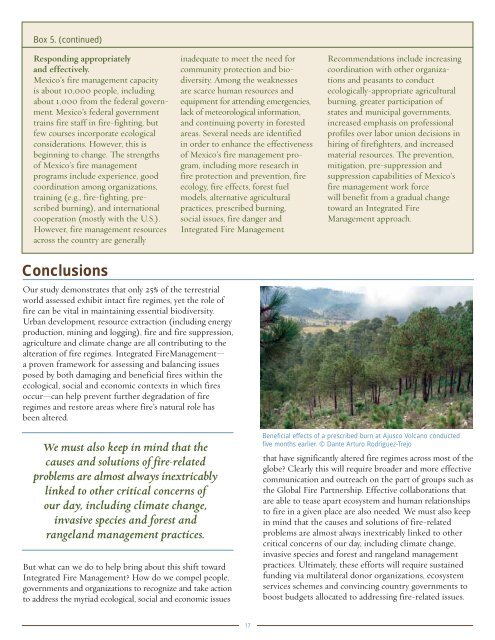Threats and Strategies for Global Biodiversity Conservation
Threats and Strategies for Global Biodiversity Conservation
Threats and Strategies for Global Biodiversity Conservation
You also want an ePaper? Increase the reach of your titles
YUMPU automatically turns print PDFs into web optimized ePapers that Google loves.
Box 5. (continued)Responding appropriately<strong>and</strong> effectively.Mexico’s fire management capacityis about 10,000 people, includingabout 1,000 from the federal government.Mexico’s federal governmenttrains fire staff in fire-fighting, butfew courses incorporate ecologicalconsiderations. However, this isbeginning to change. The strengthsof Mexico’s fire managementprograms include experience, goodcoordination among organizations,training (e.g., fire-fighting, prescribedburning), <strong>and</strong> internationalcooperation (mostly with the U.S.).However, fire management resourcesacross the country are generallyinadequate to meet the need <strong>for</strong>community protection <strong>and</strong> biodiversity.Among the weaknessesare scarce human resources <strong>and</strong>equipment <strong>for</strong> attending emergencies,lack of meteorological in<strong>for</strong>mation,<strong>and</strong> continuing poverty in <strong>for</strong>estedareas. Several needs are identifiedin order to enhance the effectivenessof Mexico’s fire management program,including more research infire protection <strong>and</strong> prevention, fireecology, fire effects, <strong>for</strong>est fuelmodels, alternative agriculturalpractices, prescribed burning,social issues, fire danger <strong>and</strong>Integrated Fire Management.Recommendations include increasingcoordination with other organizations<strong>and</strong> peasants to conductecologically-appropriate agriculturalburning, greater participation ofstates <strong>and</strong> municipal governments,increased emphasis on professionalprofiles over labor union decisions inhiring of firefighters, <strong>and</strong> increasedmaterial resources. The prevention,mitigation, pre-suppression <strong>and</strong>suppression capabilities of Mexico’sfire management work <strong>for</strong>cewill benefit from a gradual changetoward an Integrated FireManagement approach.ConclusionsOur study demonstrates that only 25% of the terrestrialworld assessed exhibit intact fire regimes, yet the role offire can be vital in maintaining essential biodiversity.Urban development, resource extraction (including energyproduction, mining <strong>and</strong> logging), fire <strong>and</strong> fire suppression,agriculture <strong>and</strong> climate change are all contributing to thealteration of fire regimes. Integrated FireManagement—a proven framework <strong>for</strong> assessing <strong>and</strong> balancing issuesposed by both damaging <strong>and</strong> beneficial fires within theecological, social <strong>and</strong> economic contexts in which firesoccur—can help prevent further degradation of fireregimes <strong>and</strong> restore areas where fire’s natural role hasbeen altered.We must also keep in mind that thecauses <strong>and</strong> solutions of fire-relatedproblems are almost always inextricablylinked to other critical concerns ofour day, including climate change,invasive species <strong>and</strong> <strong>for</strong>est <strong>and</strong>rangel<strong>and</strong> management practices.But what can we do to help bring about this shift towardIntegrated Fire Management? How do we compel people,governments <strong>and</strong> organizations to recognize <strong>and</strong> take actionto address the myriad ecological, social <strong>and</strong> economic issuesBeneficial effects of a prescribed burn at Ajusco Volcano conductedfive months earlier. © Dante Arturo Rodriguez-Trejothat have significantly altered fire regimes across most of theglobe? Clearly this will require broader <strong>and</strong> more effectivecommunication <strong>and</strong> outreach on the part of groups such asthe <strong>Global</strong> Fire Partnership. Effective collaborations thatare able to tease apart ecosystem <strong>and</strong> human relationshipsto fire in a given place are also needed. We must also keepin mind that the causes <strong>and</strong> solutions of fire-relatedproblems are almost always inextricably linked to othercritical concerns of our day, including climate change,invasive species <strong>and</strong> <strong>for</strong>est <strong>and</strong> rangel<strong>and</strong> managementpractices. Ultimately, these ef<strong>for</strong>ts will require sustainedfunding via multilateral donor organizations, ecosystemservices schemes <strong>and</strong> convincing country governments toboost budgets allocated to addressing fire-related issues.17
















